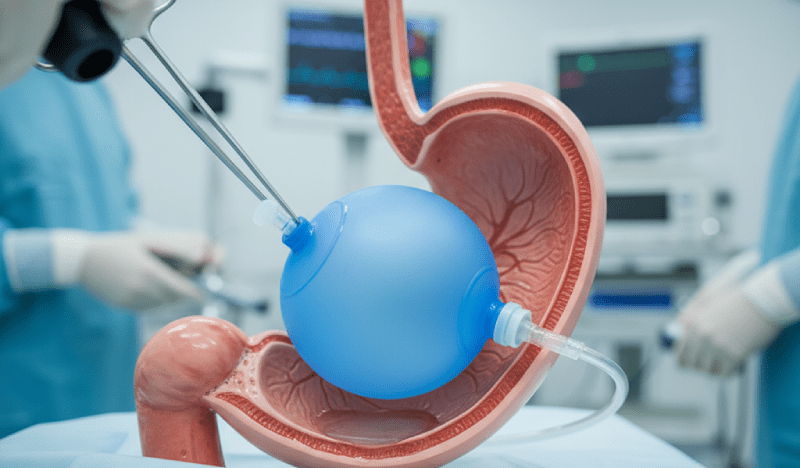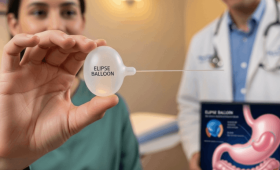What is Gastric Sleeve Surgery and How is it Performed?
Gastric sleeve surgery is a procedure in which approximately 80% of the stomach is surgically removed, and the remaining stomach is shaped into a thin, banana-shaped tube. The goal of this operation is to significantly restrict food intake, as well as to eliminate the part of the stomach that secretes the Ghrelin hormone which controls appetite. The surgery is performed laparoscopically, which speeds up the recovery process and makes the operation less invasive. A gastric sleeve is a permanent and irreversible operation because the removed part of the stomach cannot be put back.
What is a Gastric Balloon and How is it Applied?
A gastric balloon is a soft, inflatable silicone device that is endoscopically placed into the stomach (without a surgical incision) and inflated with a liquid or gas. This balloon fills a portion of the stomach, helping the patient to feel full more quickly and eat less. The gastric balloon is a temporary method and is usually removed endoscopically after 6 to 12 months. Since this is a non-surgical procedure, it does not carry the risks of surgery and is less invasive.
What Are the Basic Working Mechanisms of These Two Methods?
Gastric sleeve surgery promotes weight loss through both restriction and hormonal effect. The volume of the stomach is reduced, so less food is consumed, and because the Ghrelin hormone is secreted less, appetite decreases. The gastric balloon, on the other hand, works only on the principle of volume restriction. It takes up space in the stomach, causing the patient to feel full early. It has no hormonal effect and does not affect nutrient absorption. This fundamental difference directly impacts the weight loss success and risks of both methods.
Which Method Provides More Weight Loss?
Gastric sleeve surgery provides much more significant and permanent weight loss compared to the gastric balloon. Gastric sleeve patients can lose an average of 60-70% of their excess weight, while gastric balloon users typically lose 15-20% of their excess weight. This large difference is due to the permanent nature of the gastric sleeve and its combined effect of volume restriction and hormonal changes. The gastric balloon can be a starting point for patients with a lower BMI or those who are not suitable for surgery.
Which Method Offers a Faster Recovery Process?
Since the gastric balloon is not a surgical procedure, the recovery process is much faster. Patients can return to their normal lives on the same day or the day after the balloon is placed. Temporary side effects such as nausea and cramps may occur after the procedure. Gastric sleeve surgery, being a surgical procedure, requires a longer recovery process. Patients usually stay in the hospital for 2-3 nights, and the return-to-work period can be 1-2 weeks.
Which Method Has a Lower Risk of Complications?
The gastric balloon procedure, not being a surgical operation, has a much lower risk of complications compared to a gastric sleeve. The most common problems associated with the balloon are nausea, vomiting, and cramps. Although serious complications are rare, there are risks such as balloon rupture or intestinal obstruction. Gastric sleeve surgery, on the other hand, carries surgical risks such as staple line leaks, bleeding, and infection. These risks vary depending on the surgeon’s experience and hospital conditions.

What is the Reversibility Status of These Methods?
The gastric balloon is a completely reversible method. After a certain period (usually 6-12 months), it is removed endoscopically, and the stomach returns to its original state. This is a great advantage for patients who do not want to have surgery or are not ready for a permanent method. Gastric sleeve surgery is irreversible because a large portion of the stomach is permanently removed. Therefore, a gastric sleeve should be preferred by patients who are looking for a more permanent solution.
How is Nutrient Absorption Affected After Surgery?
Neither gastric sleeve surgery nor the gastric balloon procedure impairs nutrient absorption. Both methods work on the principle of only restricting food intake. This means that the risk of patients experiencing vitamin and mineral deficiencies is lower than with other bariatric surgery methods (like Gastric Bypass). However, since portion sizes are reduced in both methods, it is important for patients to focus on nutrient-dense foods and use supplements as recommended by their doctor.
Which Method is More Effective for Diabetes Control?
Gastric sleeve surgery is much more effective in controlling Type 2 diabetes compared to the gastric balloon procedure. The rapid weight loss and hormonal effects of the gastric sleeve can break insulin resistance and normalize blood sugar levels. The gastric balloon, on the other hand, only has an indirect effect on diabetes through weight loss and does not provide a hormonal benefit. For this reason, a gastric sleeve is a more advantageous option for patients with diabetes.
Is There a Difference in the Costs of These Methods?
Generally, the gastric balloon procedure is much more affordable than gastric sleeve surgery. The gastric balloon is more economical because it is not a surgical operation, has a short hospital stay, and requires less equipment. The cost of gastric sleeve surgery, on the other hand, varies depending on the surgeon’s experience, hospital conditions, and the services included in the surgical package. However, in the long term, the permanent results provided by a gastric sleeve can be more cost-effective.
Which Method Has More Reliable Long-Term Results?
Gastric sleeve surgery provides much more reliable long-term results due to its permanent nature and powerful effects on metabolism. The gastric balloon is a temporary solution, and there is a very high risk of weight regain if the patient returns to old eating habits after it is removed. Maintaining the weight loss achieved with a gastric balloon depends on the patient’s willpower and adherence to lifestyle changes.
Which Method Has a Shorter Procedure Time?
The gastric balloon procedure is much shorter than gastric sleeve surgery. The gastric balloon placement procedure is usually completed within 20-30 minutes. Gastric sleeve surgery, being a surgical operation, can take an average of 45 minutes to 1.5 hours. These times do not include anesthesia preparation and post-operative observation time.
In Which Situations Should Gastric Sleeve Surgery Be Preferred?
Gastric sleeve surgery is suitable for patients with a Body Mass Index (BMI) of 35 and above who have comorbidities related to obesity (diabetes, high blood pressure, etc.) or for patients with a BMI of 40 and above. It is ideal for individuals who are aiming for significant and permanent weight loss, are committed to lifestyle changes, and accept the surgical risks. This operation offers long-term and lasting results.
In Which Situations Should a Gastric Balloon Be Preferred?
A gastric balloon is a suitable option for patients with a BMI between 27-35 who are not suitable for surgery, do not want a surgical procedure, or want to control lower amounts of excess weight. The balloon can also be used as a stepping stone to surgery. The temporary nature of the method is an advantage for those who want to start the weight loss process without taking on the risks of surgery.
What Should Lifestyle Changes Be Like After the Procedure?
The success of both methods depends on lifestyle changes after the procedure. Patients should eat small, frequent meals, pay attention to protein and vitamin intake, drink plenty of water, and exercise regularly. Continuing these habits after the gastric balloon is removed is crucial to prevent weight regain. A gastric sleeve makes these habits permanent.
Which Method Has a Higher Risk of Weight Regain?
With the gastric balloon procedure, if the patient returns to old eating habits after the balloon is removed, the risk of weight regain is very high. Gastric sleeve surgery, due to its permanent hormonal and volume restriction effects, reduces the risk of weight regain. However, even after gastric sleeve surgery, if the rules are not followed, the stomach can stretch, and weight can be regained.
Is Hair Loss Normal After the Procedure?
Yes, hair loss is a normal side effect due to the rapid weight loss experienced after both gastric sleeve surgery and the gastric balloon procedure. The body tries to adapt to the rapid change by directing nutrients to vital organs. This condition is temporary and usually stops within a few months. Sufficient protein and vitamin supplementation can help to mitigate this.
Which Method Provides More Stable Weight Loss?
Weight loss with gastric sleeve surgery is more stable compared to the gastric balloon procedure. The gastric sleeve provides a permanent volume restriction, so the patient can consistently eat less. When the gastric balloon is removed, this restriction disappears, and the patient can return to their old eating habits. Therefore, a gastric sleeve offers long-term and stable weight control.
Which Method Requires Less Psychological Support for the Patient?
Neither method provides a solution for the underlying psychological issues of obesity. Therefore, psychological support is important for the success of both methods. However, since a gastric sleeve is a more radical change, patients may need more psychological support to adapt to their new lives, manage emotional eating habits, and maintain their motivation.
Are the Pre-Procedure Preparation Processes Different?
The pre-procedure preparation for gastric sleeve surgery is more comprehensive than for a gastric balloon. For a gastric sleeve, patients must be evaluated by a surgeon, a dietitian, a psychologist, and an anesthesiologist. For the gastric balloon, these evaluations can be simpler. For both methods, it is important to quit smoking and alcohol for a certain period before the procedure.
Which Method Increases Quality of Life More?
Gastric sleeve surgery significantly increases the quality of life by helping patients lose excess weight and improving obesity-related comorbidities. Patients become more mobile and can participate in social life more comfortably. While the gastric balloon also improves quality of life through weight loss, this effect may not be as permanent and strong as with a gastric sleeve.
Why is the Gastric Balloon Treatment Only Applied for 6-12 Months?
Gastric balloons are designed to withstand the acidic environment of the stomach, but this durability has a time limit. At the end of the period determined by the manufacturers (usually 6 or 12 months), the risk of the balloon wearing out and rupturing increases. Therefore, it must be removed at the end of the specified period to prevent possible complications. This period is the most important reason for the method being temporary.
Can These Two Methods Be Used Interchangeably?
Gastric sleeve and gastric balloon are not interchangeable methods. They cater to different patient groups, different BMI levels, and different expectations. The gastric balloon can be a starting point for patients looking for a non-surgical solution or who are not suitable for surgery, while the gastric sleeve is suitable for patients who want a more permanent and radical solution.

How Often Are Follow-up Appointments Made After the Procedure?
After gastric sleeve surgery, patients should have more frequent check-ups in the first year (at 1, 3, 6, and 12 months) and then continue with annual follow-ups. With the gastric balloon procedure, the patient should have more frequent follow-ups with a dietitian and doctor while the balloon is in place. After the balloon is removed, regular follow-ups and psychological support are important for patients to maintain weight control.
Which Method Carries the Risk of Dumping Syndrome?
Neither a gastric sleeve nor a gastric balloon procedure causes Dumping Syndrome. This condition is seen in surgeries that reduce nutrient absorption, such as Gastric Bypass, and occurs when sugary or fatty foods pass quickly into the intestine. Therefore, gastric sleeve and gastric balloon patients do not have a risk of encountering this type of syndrome.
How is Alcohol Consumption Affected After the Procedure?
Alcohol consumption should be strictly limited after both a gastric sleeve and a gastric balloon. Since the stomach’s volume is reduced, alcohol mixes into the blood more quickly, and the intoxicating effect is felt sooner. Also, the high calorie content of alcohol negatively affects weight loss goals. Alcohol consumption is even more risky after a gastric sleeve, as it can lead to ulcer formation on the stomach surface.
Which Method Provides Faster Weight Loss?
Gastric sleeve surgery provides faster and more dramatic weight loss, especially in the first 6 months, compared to the gastric balloon procedure. This is because of the combined effect of volume restriction and hormonal changes from the gastric sleeve. Weight loss with a gastric balloon, on the other hand, progresses more slowly and gradually. While rapid weight loss is important for patient motivation, permanent results are more valuable.
Which Method Requires More Radical Changes in Eating and Drinking Habits?
Gastric sleeve surgery requires more radical and permanent changes in eating and drinking habits. Patients must reduce their portions, consume liquids separately from meals, and eat slowly. The gastric balloon also requires similar rules, but since it is not a permanent change, the patient’s willpower comes to the forefront after the balloon is removed.
Which Method Has a Stronger Effect on Body Mass Index (BMI)?
Gastric sleeve surgery is a method designed for patients with a BMI of 35 and above and provides a very strong reduction in BMI. The gastric balloon is more suitable for patients with a BMI between 27-35 and aims for a more modest BMI reduction. Therefore, for patients with a high BMI, a gastric sleeve is much more effective.
Which Method is More Effective on Metabolic Syndrome?
The effect of gastric sleeve surgery on metabolic syndrome (high blood pressure, blood sugar, and cholesterol) is much stronger. The weight loss and hormonal changes provided by the gastric sleeve can lead to the control or complete improvement of these diseases. The gastric balloon, on the other hand, only has an indirect effect through the weight loss it provides.
In Which Situations is a Gastric Balloon Not Recommended?
A gastric balloon is not recommended for patients with swallowing difficulties, hiatal hernia, severe reflux disease, or stomach ulcers. The balloon can worsen these problems within the stomach. Additionally, it is not suitable for individuals who are not ready to follow a nutritional plan or who expect more than a temporary solution. In such cases, other treatment methods should be considered.
In Which Situations is Gastric Sleeve Surgery Not Recommended?
Gastric sleeve surgery is not recommended for patients with alcohol or substance addiction, uncontrolled psychiatric disorders, or patients who do not understand the risks of the surgery. Also, it is generally not a suitable option for individuals with a BMI below 30. In such cases, psychological counseling or less invasive methods should be considered first.
What Are the Most Important Factors in Choosing a Surgery?
The most important factors are the patient’s BMI, comorbidities, expectations, and commitment to lifestyle changes. The choice of surgery should be made in consultation with a surgeon and a dietitian, considering all of the patient’s medical history and goals. While a gastric balloon is a temporary solution, a gastric sleeve is an operation that requires a permanent lifestyle change.



